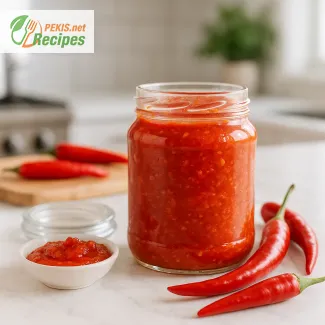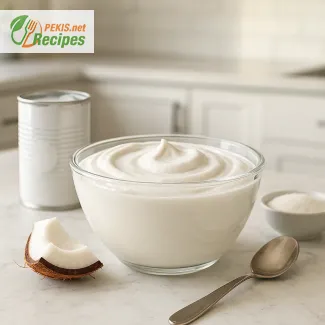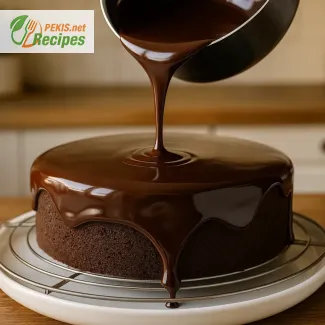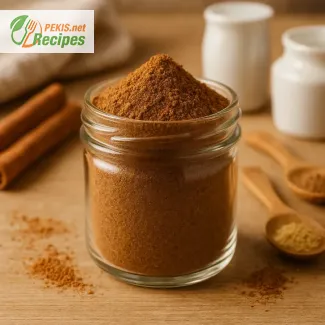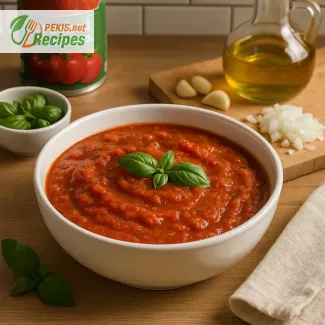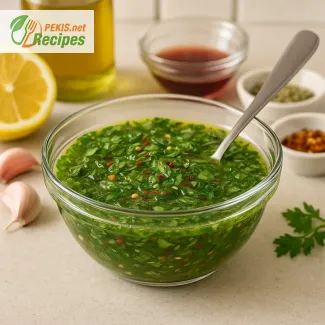
Discover the Essence of Argentina in Every Spoonful
A vibrant green sauce bursting with herbs, garlic, and bold character
Few sauces manage to capture the soul of a cuisine quite like chimichurri. Deeply rooted in Argentine culinary tradition, this herbaceous green condiment transcends borders with its lively flavor and unmistakable personality. More than just a sauce, chimichurri is a signature of South American grilling, particularly beloved for elevating grilled meats, roasted vegetables, and even crusty bread with a burst of freshness and complexity.
Origins rooted in fire and simplicity
Chimichurri originated in the pampas of Argentina and Uruguay, where gauchos (South American cowboys) would season their grilled beef with a simple blend of parsley, garlic, vinegar, olive oil, and red chili flakes. This rustic preparation wasn’t meant to overpower the meat—it was intended to complement its char and smokiness with sharp acidity, bright herbs, and just enough heat. The recipe spread quickly across Latin America and has since found a permanent home in global kitchens seeking bold, natural flavors.
Why chimichurri is more than just a steak sauce
While chimichurri is most commonly paired with grilled steak—especially Argentine asado cuts like flank, skirt, or ribeye—it’s incredibly versatile. The sauce is naturally vegan, gluten-free, and incredibly quick to prepare. It brings life to grilled chicken, fish, pork, and tofu, and acts as a tangy marinade or even a vibrant salad dressing. Its emulsion of olive oil and vinegar, combined with raw garlic and fresh herbs, creates a multi-dimensional flavor profile that balances freshness, acidity, umami, and heat.
Fresh ingredients, bold flavor
At the heart of a good chimichurri lies the quality of its ingredients. Fresh flat-leaf parsley gives the sauce its vibrant color and grassy base, while minced garlic introduces pungent depth. Red wine vinegar adds essential acidity, and extra virgin olive oil lends body and smoothness. Many traditional versions also incorporate a pinch of dried oregano, crushed red pepper flakes, and a touch of sea salt, keeping the sauce rustic yet refined.
Variations abound, with some regions substituting or combining parsley with cilantro, or adding a squeeze of lemon juice for extra brightness. Others prefer blending the sauce for a smoother texture, while purists opt for hand-chopping to preserve the herb’s integrity and visual appeal.
Chimichurri as part of modern cooking
In today’s culinary landscape, chimichurri sauce has evolved from its humble roots into a globally recognized flavor enhancer. It’s now featured in fusion cuisine, topping everything from tacos and burgers to grain bowls and grilled halloumi. Food enthusiasts embrace its freshness and simplicity, using it to bring an earthy, zesty kick to both traditional and contemporary dishes.
Its appeal lies not only in its taste but in its practicality. Chimichurri can be made in under 10 minutes, stored for days, and adapted endlessly. Whether spooned generously over a juicy steak or drizzled onto grilled vegetables, it creates an instant upgrade to even the simplest meal.
Authenticity meets adaptability
A key strength of chimichurri is its balance between tradition and flexibility. While the authentic Argentine recipe remains the gold standard, today’s home cooks and chefs feel empowered to adjust it according to taste and occasion. This means experimenting with smoked paprika, shallots, basil, or even incorporating avocado for creaminess.
No matter how it’s interpreted, the core of chimichurri remains unchanged: raw, natural ingredients used to celebrate the food it touches. It's not meant to be cooked, nor should it be served hot—it is, at its heart, a raw preparation that emphasizes flavor over complexity.
The perfect complement for grilling season and beyond
Chimichurri continues to gain popularity across cooking blogs, social platforms, and restaurant menus because it fits so effortlessly into a variety of diets and cuisines. It speaks to modern tastes: fresh herbs, bold flavors, fast preparation, and culinary authenticity. With just a few pantry staples and some fresh parsley and garlic, you can prepare a sauce that feels exotic, yet incredibly approachable.
Whether you’re planning a summer barbecue, searching for a flavorful marinade, or looking to refresh your weeknight dinners, chimichurri offers a solution that is as timeless as it is trendy. It’s a celebration of green—an expression of simplicity, balance, and bold character that comes alive with every spoonful.
- Prepare the herbs and garlic: Finely chop the fresh parsley by hand or pulse briefly in a food processor (do not puree). Mince the garlic cloves finely to avoid harsh bites.
- Mix the dry ingredients: In a bowl, combine the parsley, minced garlic, dried oregano, red pepper flakes, sea salt, and black pepper.
- Add acidity: Pour in the red wine vinegar and stir to blend the dry ingredients evenly.
- Incorporate the oil: Slowly add olive oil, stirring constantly until fully combined. The oil should lightly coat all ingredients without pooling.
- Optional step: Add a tablespoon of lemon juice for extra brightness if desired.
- Let it rest: Cover the sauce and let it rest at room temperature for at least 20 minutes to allow the flavors to meld.
- Serve and store: Serve as a topping or marinade. Store leftovers in an airtight container in the refrigerator for up to 5 days.
Elevate Your Chimichurri: Expert Tips for a Next-Level Sauce
Transforming a rustic classic into a custom flavor masterpiece
Though chimichurri is praised for its simplicity, it’s also a remarkably adaptable recipe that invites creativity without losing its traditional charm. Whether you’re making it for the first time or looking to refine your go-to version, small adjustments can lead to a dramatically enhanced flavor experience. With the right techniques and ingredient tweaks, you can bring out deeper aromas, create new textures, or tailor the sauce to specific dishes or dietary preferences.
How ingredient variations shape flavor and texture
While the foundation of chimichurri—parsley, garlic, vinegar, olive oil, and spices—remains consistent, subtle changes to ingredients can alter the sauce in meaningful ways. For example, swapping red wine vinegar with sherry vinegar creates a slightly sweeter, more rounded acidity that softens the sharpness of raw garlic. Adding a handful of fresh cilantro can introduce a citrusy note, common in variations across Latin America, particularly in Peru and Mexico.
To elevate the herbaceous character, some chefs incorporate basil or mint, especially when pairing chimichurri with lamb or grilled vegetables. Introducing a small amount of shallot—minced and soaked in vinegar beforehand—adds a gentle sweetness and additional aromatic complexity, making the sauce feel more refined without overpowering its rustic essence.
Choosing oil wisely: why it matters
While traditional recipes use extra virgin olive oil, the oil’s flavor profile can significantly affect the finished sauce. A mild, fruit-forward oil will let the herbs and garlic shine, while a peppery, bold olive oil adds bite and richness. For those seeking a more neutral base, grapeseed or avocado oil offer a lighter alternative that allows other ingredients to take the lead. These oils are also higher in monounsaturated fats, making them a favorable option for those watching their cholesterol intake.
Homemade chimichurri: freshness that bottled versions can't replicate
No store-bought version can match the brightness and vibrancy of freshly made chimichurri. Bottled sauces often contain preservatives, stabilizers, and added sugars, which dull the sharp herbal flavor and alter the sauce’s natural texture. Homemade versions let you control everything—from the level of salt to the intensity of heat—ensuring the sauce complements your dish exactly as intended.
Fresh herbs oxidize quickly, so a homemade chimichurri should be consumed within a few days for optimal flavor. The freshness of the garlic and quality of oil also impact how long the sauce retains its depth and aroma. Preparing it in small batches is a simple way to maintain both quality and food safety.
Avoiding common mistakes in preparation
Despite its short ingredient list, chimichurri is often misunderstood or misprepared. One frequent mistake is using a blender or food processor for too long, which creates an overly smooth texture and dulls the herbs’ color and flavor. A coarse chop preserves both visual appeal and textural integrity, while ensuring the flavors meld naturally.
Another misstep is adding the oil too early—before the vinegar has a chance to infuse the herbs and spices. To get the most balanced result, the acid and aromatics should be combined first, allowing time to mellow, followed by a slow stream of oil for a light emulsion.
Some cooks also overdo the garlic, which can turn the sauce acrid or overly sharp, especially when it sits for a day. If you’re unsure of your garlic’s pungency, use half the amount and taste after resting.
Health-conscious tweaks for a lighter chimichurri
Traditional chimichurri isn’t unhealthy, but it can be modified to suit various diets. For a low-sodium version, reduce added salt and rely more on lemon juice or vinegar to lift flavor. Garlic-infused oil can be used instead of raw garlic to suit low-FODMAP needs. Those watching their fat intake can use half the oil and balance it with a bit of water or vinegar—while the texture changes slightly, the flavor stays bold and bright.
For a nutrient boost, blending in kale or baby spinach increases the fiber and vitamin content without affecting the core taste. Adding toasted sunflower or pumpkin seeds can introduce healthy fats and a subtle nuttiness, making the sauce more textured and filling, especially when used as a salad dressing or grain bowl topping.
Pairing ideas beyond grilled meat
Although it’s synonymous with steak, chimichurri can shine in far more contexts. Try it as a pizza drizzle, a dip for roasted potatoes, or a spread in sandwiches and wraps. Toss it with cooked grains like quinoa or farro for an easy salad base, or fold it into Greek yogurt or hummus for a creamy herb dip.
Used as a marinade, it can add depth to chicken, shrimp, tofu, or portobello mushrooms, especially when left to rest overnight. The acidity tenderizes, the herbs brighten, and the garlic imparts richness, turning basic proteins into flavor-packed centerpieces.
Making it your own, while respecting tradition
The beauty of chimichurri lies in its balance of boldness and adaptability. You can honor its roots while letting it evolve alongside your kitchen style. Whether you're preparing it for a summer grill party or a weekday dinner, this sauce has the ability to turn even the most ordinary dish into something memorable. Keeping a jar of chimichurri in your fridge might be the simplest way to bring global flavor into your everyday meals.
Allergens present in the recipe:
- None directly present. However, garlic may be a FODMAP trigger for sensitive individuals.
- No gluten is present in the recipe.
Suggestions to remove allergens and gluten:
- Replace garlic with garlic-infused oil to reduce FODMAP content while preserving flavor.
- Confirm all spices and vinegar are certified gluten-free, especially if cross-contamination is a concern.
Vitamins and minerals per serving (approximate):
- Vitamin K: 240 µg – supports blood clotting and bone health
- Vitamin C: 8 mg – boosts immune function and antioxidant defense
- Vitamin A: 410 IU – contributes to vision and skin health
- Iron: 1 mg – important for oxygen transport
- Potassium: 90 mg – supports heart and muscle function
- Calcium: 40 mg – essential for bone and dental health
Antioxidants per serving (approximate):
- Luteolin (from parsley): 1.1 mg – anti-inflammatory and neuroprotective
- Oleocanthal (from olive oil): 2.5 mg – mimics anti-inflammatory properties of ibuprofen
- Flavonoids (varied, from parsley and garlic): 3 mg – general cellular protection and immune modulation
- Allicin (from garlic): 5 mg – antimicrobial and cardiovascular health support
